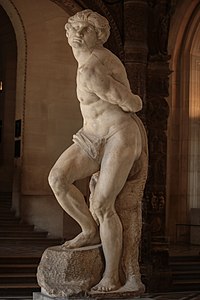Rebellious Slave
| Rebellious Slave | |
|---|---|
 |
|
| Artist | Michelangelo |
| Year | 1513 |
| Type | sculpture |
| Medium | Marble |
| Dimensions | 215 cm (85 in) |
| Location | Louvre, Paris |
The Rebellious Slave is a 2.15m high marble statue by Michelangelo, dated to 1513. It is now held in the Louvre in Paris.
The two "slaves" of the Louvre date to the second version of the tomb of Pope Julius II which was commissioned by the Pope's heirs, the Della Rovere in May 1513. Although the initial plans for a gigantic mausoleum were set aside, the work was still monumental, with a corridor richly decorated with sculpture and Michelangelo was immediately put in charge of the work. Among the first pieces completed were the two "Prigioni" (renamed the "slaves" only in the nineteenth century), destined for the lower part of the funerary monument, next to the pilasters which framed the niches containing the Victories. Their poses were determined by the needs of this architectural setting, so from the front they have great effect, but the side views received less care than usual.
The date of the two statues is confirmed by a letter of Michelangelo to Marcello dei Covi, in which he speaks of a viewing by Luca Signorelli in his Roman house, while he worked on "a figure of marble, standing four cubits high, which has its hands behind its back".
All the "Prigioni" produced in the studio of the artist were eliminated from the monument in its final version, completed in 1542. In 1546 Michelangelo gave the two works in the Louvre to Roberto Strozzi, for his generous hospitality in his Roman house during Michelangelo's periods of sickness in July 1544 and June 1546. When Strozzi was exiled to Lyon in April 1550 for his opposition to Cosimo I de' Medici, he had the two statues sent ahead. In April 1578 they were put on view in two niches in the courtyard of the castle of the constable of Montmorency at Écouen, near Paris.
In 1632 they were sold by Henri II de Montmorency to Cardinal Richelieu, who had them sent to his Château in Poitou, where they were seen by Gianlorenzo Bernini who made an illustration of them, on his travels.
...
Wikipedia
